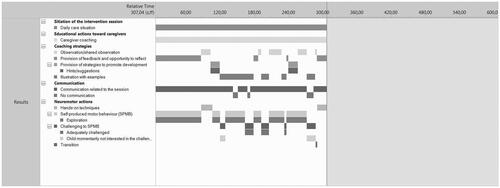Figures & data
Table 1. Differences in categories and behaviors (continuous variables) between the WOP and the GOP 2.0.
Table 2. Differences in the categorical variables of the WOP and the GOP 2.0.
Figure 1. Illustration of the WOP-analysis of a 5-min sequence of an intervention video. In bold the 5 WOP-categories are denoted and below each category, the applied behaviors and modifiers are listed. The onset of a bar indicates the onset of a behavior/modifier, the end of the bar the end of the behavior/modifier, implying that the length of the bar indicates the duration (time spent with) of that behavior/modifier. Addition of all duration values results in the total time spent with a specific behavior/modifier, which is expressed as a proportional value, i.e., as the percentage of total intervention time. In this example 100% of the time was spent with “caregiver coaching,” approximately 20% of the time with “observation/shared observation,” and approximately 36% with “provision of feedback and the opportunity to reflect.”

Table 3. Characteristics of study participants.
Table 4. Intra-rater and inter-rater agreement on continuous items assessing behaviors and modifiers of the WOP.
Table 5. Coaching behaviors over time.
